MERITS AND DEMERITIS OF MENDEL
MERITS:-
Mendel was successful in his work where others had failed.
He was very systematic and scientific in his researches and data analysis and for this reason he managed to come out with the laws of inheritance.
He realized the role of gametes in the transfer of genetic information from parents to the offspring.
The secret behind Mendel’s success is within the following facts:-
Preliminary investigations were carried out to obtain familiarity with experimental organisms.
He paid attention to one characteristic at a time.
He used organisms with limited continuous variations
Meticulous care was taken during data collection and analysis so as to avoid introduction of contaminating variables.
He collected sufficient data to have statistical significance
DEMERITS:
The shortfalls of Mendel include the following:-
His gametes describe only the diploid sexually reproducing organism. The haploid organisms such as Bryophylum are not explained.
(b) His gametes is only based on the dominating- recessiveness principle’s but not all the time that one characteristic is dominant over the other.
(c) Not all the time genes assert freely. Linkage enterferes was free assortment.
(d) Mendel did not consider gene interaction such as epistesis collaboration, lethal genes etc all of which interfere with his basic ratio.
More examples:
-
The position of starch in pollen grains in maize is controlled by the presence of one allele of certain gene. The other allele of that gene results in starch being deposited. Explain in terms of reasons why half the pollen grains produced by a heterozygous plant contain starch.
Solution:
The two alleles segregate during metaphase I and anaphase I.
-
Calculate the number of different combination of chromosomes in the pollen grains of the cross (cross balance) which has a diploid number of six (2n = 6).
Solution
The number of different combination of chromosomes in the pollen grants cell is calculated, using the formula 2n, whore n is the haploid number of chromosomes.
Since 2n = 6, n = 3
Therefore, combination = 23 = 8
NON – MENDELIAN GENETICS
This is simply a pattern of inheritance in which the basic Mendelian ratios are modified.
Examples:
INCOMPLETE DOMINANCE (under gene interactions)
Incomplete dominance/ Blending – Is a type of inheritance in which there occur the apparent failure of one allelic gene to dominate the other that when the two genes are together, they produce a character between them.
Example
A cross between a white Andalusian (fowl) and a black Andalusian produce a blue variety in the F1 generation. When the F1 members are selfed, the F2 individuals are a mixture of phenotypes ie: black, blue and white in the ratio of 1:2:1
Illustration:
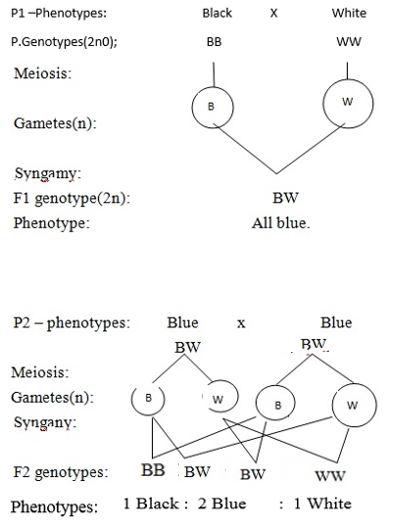
edu.uptymez.com
Genotype ratio: 1 BB : 2 BW : 1 WW
Phenotype ratio: 1 black : 2 blue : 1 white
QN. NECTA 1993
A genetist who was verifying Mendel’s first law and second law crossed 45 homozygous red flowered plants with 45 homozygous white flowered plants. The resulting F1 were 530 plants all with pink flowered plants, the seeds obtained were planted and F2 offspring with the following phenotypes were obtained.
1292 red flowered.
2570 pink flowered.
1290 white flowered.
(a) Illustrate using symbols the crosses made and the results obtained in the experiment described above.
(b)(i) What is the name above experiment?
(ii) How do the above observations differ from the results of Mendelian work which led him to formulate his laws of inheritance?
(c) Describe the genetical test you would carry out to prove weather not the appearance of the pink flower in the above experiment is true deviation from Mendel’s principles of inheritance (20marks).
Solution:
(a) Let R – allele for red colour.
W – allele for white colour.
RW – genotype for pink colour (flower).
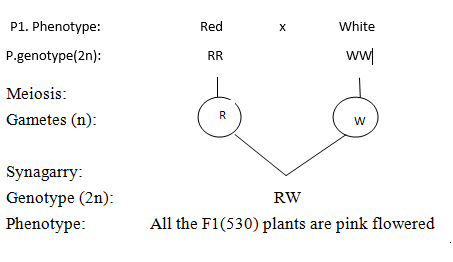
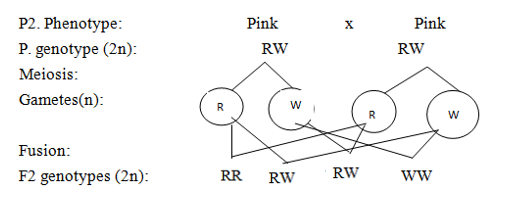
The F2 members are 1292 red flowered, 2570 Pink flowered, 1290 White flowered
(b) (i) The name of the mode of inheritance is Incomplete dominance inheritance.
(ii) The observation differ from Mendelian principles in that, the inheritance the flower colour does not follow the dominance – recessiveness principle.
All the F1 offsprings are pink flowered instead of them to show the dominant colour from either of the experiment is fully dominance or fully recessive. In the Mendelian experiment, when F1 are selfed
the resulting one in the dominance-recessive phenotypes ratio is of 3:1. But in this experiment, selfing the F1 individuals give 1:2:1.
(c) The genetical test to be carried out is back test cross in which the pink flowers plant will be test crossed with either of the homozygous plants say red flowered plant RR.
The result of the test cross above will give products of red (RR) and pink (RW) in the ratio of 1:1.
- The above results show a siltation of RW (Pink) and RR (red). This can prove that there has been no true blending, has occurred in F1 generation then we could expect offspring which were again all pink flowers.
- The appearance of pink colour trait in the F1 generation is not a true deviation from Mendel’s laws; otherwise the gene for red could not be reviewed unchanged.
-
It was just observed when in the presence of WW (White) while its identity was being retained.
Thus, the inheritance of the flower colour in the experiments precisely obeys Mendel’s principle of inheritance only the phenotype ratios are different.
Partial dominance (Co dominance & Incomplete dominance)
Sometimes both alleles express themselves in the phenotype, but one more so than another. This is an intermediate stage between complete dominance and co dominance.
LINKAGE
For just 23 pairs of chromosomes to determine the many thousands of different human characteristics, it follows that each chromosome must possess many different genes.
Any two genes which occur in the same chromosome are said to be linked. All the genes on a single chromosome form a linkage group.
Under normal circumstance, all the linked genes remain together during cell division and so pass into the gamete, and hence the offspring, together. They not therefore segregate in accordance with Mendel’s law of Independent Assortment.
The figure below shows the different gametes produced if a pair of genes A and B are linked rather than on separate chromosomes.
edu.uptymez.com
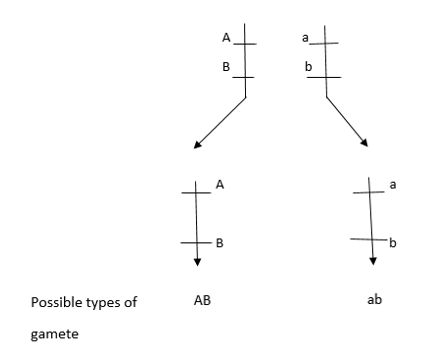
If gene A and B occur on separate chromosomes ie. are not linked
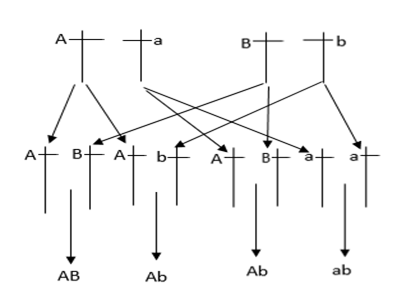
NOTE: Linked genes do not confirm to Mendel’s principle of independent assortment, therefore they fail to produce the expected 9:3:3:1 ratio in a breeding situation involving the inheritance of two pairs
of contrasted characters (dihybrid inheritance).
Crossing over and crossover values (COV)
During cross over (in chiasmata formation), the alleles of parent linked group separate and new associations of alleles are formed in the gamete cells, a process known as genetic recombination.
Offspring formed from these genes showing ‘new’ combinations of characteristics are known as recombinants. Hence crossing over is a source of variations.
The recombination frequency (COV) is calculated using the formula
no. if individual showing recombination x 100
no. of offspring
Gene mapping
Calculation of COV enables geneticists to produce maps showing the relative positions of genes on chromosome. Chromosome maps are constructed by directly converting the COV between genes into
hypothetical distances along the chromosomes.
Sex determination
Sex is a state of being male or female.
In human there are 23 pairs of chromosomes of these 22 pairs are identical in both sexes. The 23rd pair, however is different in the male from the female.
The 22 identical pairs are called autosomes, the 23rd pairs are referred to as sex chromosomes or heterosomes.
In females the two sex chromosome are identical (X chromosomes) are said to be Homogametic, while in males the two chromosomes are non- identical (Y – chromosome is smaller in size than X –
chromosome) and are said to be Heterogametic.
Unlike other features of an organization, sex is determined by chromosomes rather than genes.
Humans of genotype XXY are phenotypically male, while genotypes with just one X chromosome (XO) are phenotypically female. This suggests that the presence of the Y chromosome which makes the human male, in its absence the sex is female. How does the Y chromosome determine maleness?
The Y chromosome possesses several copies of a testicular differentiating gene which codes for the production of a substance that causes the undifferentiating gonads to become testes. In the absence of the gene and hence this substance, the gonads develop into ovaries.
- In humans, sex is determined by the type of sex chromosome contained in the spermatozoa that fuses with an X – chromosome of the egg cell.
- If the X – chromosome bearing sperm fuses with an X- chromosome of the egg cell, the resulting zygote will develop into a female (XX).
- If the Y- chromosome bearing sperm fuses with an X – chromosomes of the egg cell, the resulting zygote will develop into a male (XY).
edu.uptymez.com
Consider a cross below
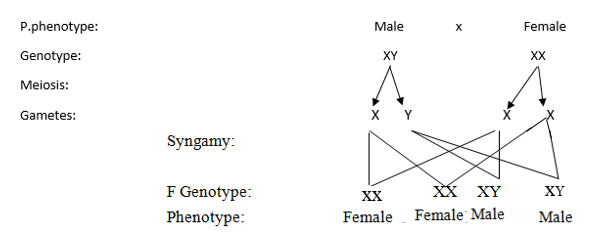
From this cross it is evident that;
(i) The chances of a zygote develop into a male or female are 50%
(ii) The sex of the individual before to be born is determined by the father.
Sex determination differs in other organisms. In birds, most reptiles and fish and all butterflies, the male is the homogametic sex (XX) and the female is from the cross, all the resulting individuals are phenotypically normal with all females beings carriers.
Questions.1.A certain species of flies has, the following genetic attributions
- Female flies have two X- chromosomes (XX).
- Male flies have one X- and one Y – chromosome.
- Y chromosome does not bear extra genes.
-
Eye colour is sex linked and red colour is dominant over white eye colour trait.
What will be the genotype and phenotype of the female and males in the F1 and F2 when;
- White eyed female is crossed with a red eyed male.
-
A homozygous red eyed female is crossed with a white eyed male.
2.Siku and her brother Juma have their elder brother who is haemophilic. They and their parents are normal but they are worries that they may have haemophilic children in future. If they approach you for help how would you advice them?
3. A homozygous purple flowered short-stemmed plant was crossed with a homozygous stemmed-flowered long stemmed plant and the F1 phenotypes had purple flowers and short stems. When the F1
4. generation was test crossed with a double homozygous recessive plant the following progency were produced.
52 Purple flower, short stem.
47 Purple flower, long stem.
49 red flower, short stem.
45 red flower, long stem.
Explain these results fully.
The F1 phenotypes show that purple flower and short stem are dominant and red flower and long stem are recessive. The approximate ratio of 1:1:1:1 in a dihybrid cross suggests that the two genes controlling the characteristics of flower colour and stem length are not linked and the four alleles are situated on different pairs of chromosomes (see below).
Let P- Purple flower
p – Red flower
S – Short stem
s – Long stem
Since the parental sticks were both homozygous for both characteristics the genotypes must be PpSs.
Test cross phenotypes: Purple flower short stem x red flower, long stem
Test cross genotype: PpSs ppss
edu.uptymez.com
| gametes | PS | Ps | ps |
| ps | PpSs | Ppss | ppss |
edu.uptymez.com
Meiosis:
Gametes (n):
Random fertilization
(shown inpunett square):
Offspring genotypes (2n)
(Listed in each square):
Offspring phenotypes: 1 purple flower, short stem : 1 purple flower, long stem.
1 red flower, short stem : 1 red flower long stem.
MULTIPLE ALLELISM
Multiple alleles are those alleles of a single locus when there are more than alternatives in a population.
In humans, the inheritance of the ABO blood groups is determined by a gene which has different alleles. Any two of these can occur at a single locus at one time.
Allele A causes production of antigen A on red blood cells.
Allele B causes production of antigen B on red blood cells.
Allele O causes no production of antigens on red blood cells.
Alleles A and B are codominant and allele O is receive to both.
The transmission of these alleles occurs in normal Mendelian fashion.
A cross between an individual of group AB and one of group O therefore gives rise to individuals non of whom possess either parents blood group.

Phenotype: blood group AB x blood group O
| gametes
|
|||
| IA | IB | ||
| gametes | IO | IA IO | IB IO |
edu.uptymez.com
Paternity suits.
Although blood group cannot prove who a father of a child is, it is possible to use inheritance to show that an individual could not possibly be the father.
Imagine a mother who is blood group B having a child of blood group O. She claims the father is man whose blood group is found to be AB. As the child is group O, its only possible genotype is IO IO. It
must therefore herited one IO allele from each parent. The mother, if IB IO could donate such an allele. The man with blood group AB can only have the genotype IA IB. He is unable to donate an IO allele
and cannot therefore be the father.
Dominance series
Coat colour in rabbits is determined by a gene C which has four possible alleles.
Alleles CF determines full coat colour and is dominant to
Allele CCH which determines chinchill a coat and is in turn dominant to
Allele CH which determines Himalayan coat and is in turn dominant to
Allele CA which determines albino coat colour.
There is therefore a dominance series and each type has a range of possible genotypes.
Inheritance is once again in normal Mendelian fashion.
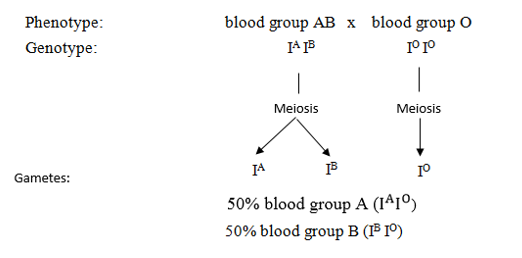
Other characteristics controlled by multiple alleles are coat colour in mice, eye colour.
Worked examples
-
A woman of blood group A claims that a father of blood group B is the father of her child whose blood group is O. How far are the woman’s claims valid?
Answer.
If both are heterozygous for their blood groups, then the woman’s claims are valid, but if either of them is homozygous for the blood group then women’s claims are invalid.
-
Anna is a woman married to John. This couple once had a child, Kitto was one day discovered that his parents were in bad terms. John claims that Kitto is an illegitimate child but Anna is opposing the case. Blood tests rewards that John is of type A and Kitto is of blood group O. Anna’s mother blood type is B and Anna’s father blood group type is AB. Using this information alone
(i) Suggest the possible genotype for Anna, show how you determine genotype.
(ii) Show dearly whether Kitto is or he is not an illegitimate child of the said family.
Solution:
-
Since Kitto is of blood group O, then his genotype is of no doubt.
This implies that the genotype for Anna should have an allele IO considering Anna’s parents we have:
Mother: Blood group B whose possible genotypes are IB IB or IB IO
Father: Blood group AB whose possible genotype is IA IB
edu.uptymez.com
- But for Anna to have an allele IO in her genotypes, the mother should bear the allele IO. Thus, the genotypes should be IBIB
edu.uptymez.com
A cross between Anna’s parent reveals the following;
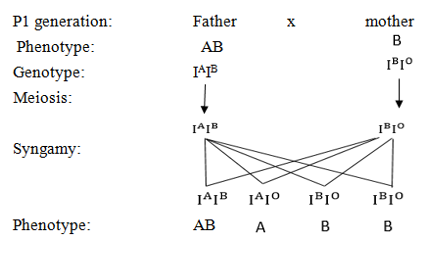
-
Since Anna is heterozygous for her blood group and John is of blood group A, then the legitimacy of Kitto will depend on John’s genotype. If he is heterozygous for his blood group, then Kitto is a legitimate child as the cross below reveals.
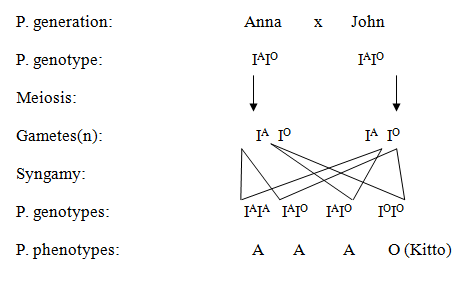
If John is homozygous for his blood group, then for sure, Kitto is an illegitimate child of the family.
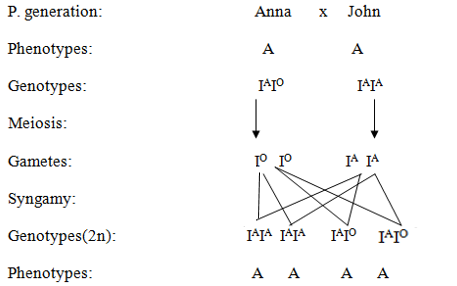
3. Write an essay on the statement that “the knowledge on the inheritance of blood group can be used to tell for sure that “the baby is not Yours” rather than the baby is yours”
4. Mama is a form six student with blood group A. She recently has a baby whose father she insisted was her fellow student Kashesha. Kashesha refused paternity and this paternity case was taken to court where the following facts were established. Kashesha’s mother blood group A; Kashesha’s father blood group B. Baby blood group O. Based on this factor explain whether the law will accuse or excuse Kashesha.
Sex Limited and sex influenced characters:
Sex limited characters are those characters that are concerned to only one sex eg. baldness, beards and Adam’s apple in males and enlarged breasts and hips in females.
edu.uptymez.com
The development of such character is controlled by sex hormones, they are thus said to be sex influenced characters.
PEDIGREE ANALYSIS
Pedigree is a sequential arrangement of individual in a given family to show the passage of certain character from one generation to another.
In analyzing a pedigree the first individual to show the characters of interest is called a propositous
Features of a pedigree.
(i) Circles represent females, squares represent males.
(ii) Shaded figures show a phenotypic expression of the character, open figures represent a normal phenotype.
(iii) Parents are connected by a horizontal line as children are connected to parents by vertical line.
Worked examples
-
Study the pedigree shown below, circles represent females, squares represent males, shaded figures represent colour blindness, open figures represent normal phenotype
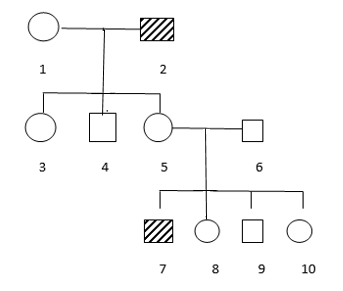
edu.uptymez.com
(i) What is the probable genotype for 1?
(ii) What are the possible genotypes for 5 and 9?
(iii) If 8 marries a normal man, what are the chance that she will have a colour blind son?
Solution
Consider the following genetic attribute;
XNXN – Normal female.
XNXn – Carrier female.
XnXn – Colour blind female.
XNY – Normal male.
XnY- Colour blind male.
(i) The possible genotype for 1 is XNXN ie: homozygous normal.
(ii) The possible genotypes for, 5 is XNXn ie: heterozygous normal
(iii) Since 8 was born from a certain mother, she has 50% chance of receiving an allele for colour blindness.
There are also 50% chances that the allele will pass to the son.
Thus, the chances of 8 to have a colour blind son are:
½ x ½ x ½ = 1/8
(a) State Mendel’s laws of inheritance.
(b) In dogs coat colour is determined by a series of multiple alleles. The allele As produces a uniformly dark coat, the allele ay produces a tan coat and the allele at produces a spotted coat. The dominance heredity achy is As > ay > at which means As is dominant to both ay and at where ay is dominant to at only.
A family tree for dogs showing their coat colours is given below;
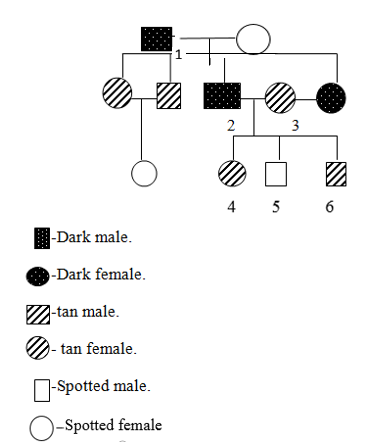
- State the genotype of each of the individuals 1 – 5
-
By means of genetic diagram deduce the possible genotypes and phenotypes of the puppies which could be produced by mating between individual 4 and 6
Solution
(b) (i) Given dominance hierachy As > ay > at
Phenotype: Possible genotypes
Dark: AsA,s Asay,Asat
Tan: ayay,ayat
Spotted: atat
Thus, the genotypes are:
edu.uptymez.com
| Individual | Genotype |
| 1 | Asay |
| 2 | Asat |
| 3 | ayay |
| 4 | atat |
| 5 | ayat |
edu.uptymez.com
Crossing between individual 4 and 6
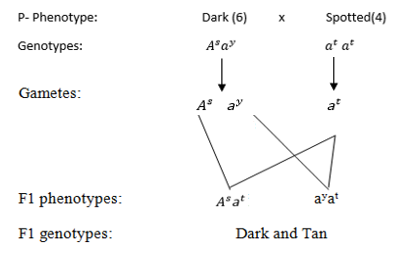
More examples:
-
In cats, the genes controlling the coat colour are carried on the X chromosome and are codominant. A black coated female mated with a ginger coat produced a litter consisting of black male and tortoise shell female kittens. What is the expected F2 phenotypic ratio? Explain the results.
Soln:
Let B represent black coat colour.
G represent ginger coat colour.
XX represent female cat.
XY represent male coat.
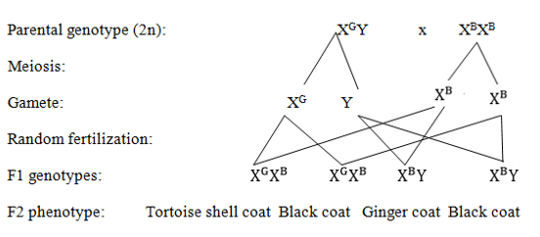
Colour female colour female colour male colour male
(The parental female must be homozygous for black coat colour since this is the only condition to produce a black coat phenotype).
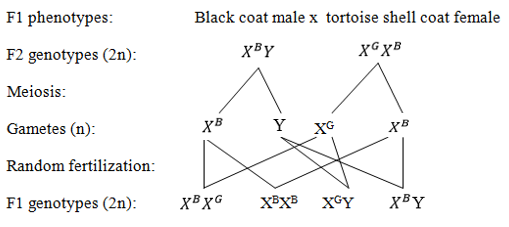
F2 phenotypes: Tortoise shell coat colour female : black coat colour female : ginger coat colour male : black coat colour male
-
(a) Explain using appropriate genetic symbols, the possible blood groups of children whose parents are both heterozygous, the father being blood group A and mother B.
(b) If these parents have non – identical twins, what is the probability that both twins will have blood group A?
Answer
(a)Let: I represent the gene for blood group
A Represent the allele A (equally dominant)
B Represent the allele B
O represent the allele O (receive)
(b) There is a probability of ¼ (25%) that each child will have blood group A. So the probability that both will have blood group A is ¼ x ¼ = 1/16 (6.25%)
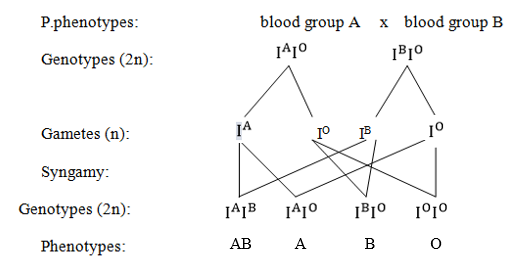
edu.uptymez.com